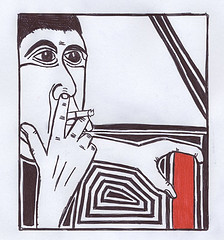Yesterday saw the trial run of People vs Process: Cultural Patterns of Software Organisations. We had a lively session with eleven active and critical (in a good sense) participants. We got useful feedback for the next rounds, and a solution for a puzzle we couldn’t solve before: an example organization with a congruent culture.

congruent? by Alexander Aden
As Nynke Fokma puts it:
“Congruent culture: starship enterprise -> when going somewhere, we can go where no one has gone before, we can carry anything and we can beam ourselves anywhere, but this is all science fiction, or is it”
As Jerry Weinberg describes it:
“Everyone is involved in improving everything all the time.”
So far we had come up with Toyota as a possibility. However, I’m a bit wary of using Toyota as an example – the risk of a Toyota cargo cult in IT is slightly too big to use it all the time. Searching around, you can find gems like Two Faced Toyota :
“Meanwhile, Toyota’s playing footsie with federal regulations. Their Texas-built pickup hits dealer showrooms in February– at the same time other manufacturers are beginning to introduce some of their 2008 models. But Toyota is adamant the new Tundra is an ’07. That’s because the U.S. government is changing the way they calculate the fuel mileage ratings for ‘08 model year pickups. [..]
As you can imagine, Toyota’s heavy emphasis on their new gas-guzzling leviathan hasn’t gone unnoticed by auto-oriented environmentalists. In fact, environmental groups are finally facing reality: their automotive eco-darling is (gasp!) nothing more than a business. A business that conforms to all CAFE regulations, of course, but will do whatever it takes to make a profit. “
Porsche came up as a possible alternative, now the most profitable car maker. I read about it in the financial times, and should have kept a clipping. They say so themselves in the Porsche Principle, and this:
“On the labour market, because to secure our long-term success we don’t eliminate jobs, we secure and create them. On the business base issue, because we are committed to Germany and are a constant reminder to others that one can succeed here too. “
Sounds good, but whenever I see one of their gaz-guzzling high speed SUV’s pass by, I don’t know. Not bad for a car maker, and very effective and efficient. But still a car maker.
A participant suggested Semco. Marc and I went… Duh! We knew about that one, but somehow it didn’t come up during the preparation. Semco is a federated business, operating out of Brasil. It’s ceo Ricardo Semler wrote about it in the Seven Day Weekend :
“At the risk of offering a description, Semco is a federation of businesses with a minimum common denominator. What I mean is we are not monolithic, yet there are common themes and threads uniting us. All our business units are highly engineered, premium providers and market leaders in their niches. We haven’t ventured into any of them by chance.”
From their values page:
10 – Have the humility to recognize our errors and understanding that we can always improve.
Sounds close enough.
So, now we’re still looking for examples of a congruent culture example in IT or electronics. Or something to dispell our happy feeling about Semco. Anyone?




 For some reason this second programmer sees the install script as a
For some reason this second programmer sees the install script as a
